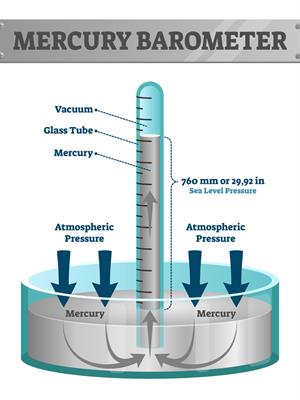PDF chapter test TRY NOW
Rain
Rain is liquid precipitation of water droplets falling from the sky. Raindrops fall to Earth when clouds become saturated with water droplets, and they become heavy enough to fall under gravity.
Rain is a major component of the water cycle and is responsible for depositing most of the fresh water on the Earth. It is the primary source of water for almost all purposes. There is a close relationship between temperature and rainfall distribution. Generally, rainfall is high in the equatorial region and decreases gradually towards the poles. A rain gauge is used to measure rainfall.
Air pressure
In a barometer, a column of mercury in a glass tube rises or falls as the weight of the air column above changes. Meteorologists describe the atmospheric pressure by the rise or fall in mercury level in the tube.
An atmosphere (atm) is equal to the average air pressure at sea level at a temperature of 15 degrees Celsius. One atmosphere is 1,013.25\ millibars or 760 millimetres of mercury. At the Earth’s surface, the pressure is 1.03kg. Per\ sq\ cm. The standard atmospheric pressure varies both horizontally and vertically.
It may be categorised into high or low pressure based on the level of pressure exerted. If an area experiences pressure lower than its surroundings, it is called a low-pressure area. The wind from the surrounding high-pressure area blow towards the centre of low pressure.

Similarly, if a barometric pressure of a region is higher than that of its surrounding, it is called a high-pressure region, and the wind blows outwards from the centre of high pressure towards low-pressure regions.
On the map, Low pressure is marked as "L", and high pressure is marked as "H". Low-pressure systems are also called depression and cyclones. A high-pressure system is called anticyclones.
Low pressure leads to wind, cloudiness, and precipitation. Whereas High pressure regions experience fair and calm weather.
The distribution of air pressure is shown using isobar.
Low pressure leads to wind, cloudiness, and precipitation. Whereas High pressure regions experience fair and calm weather.
The distribution of air pressure is shown using isobar.
Highest pressure ever recorded:
The highest ever air pressure at sea level: At Agata, Russia, on 31st December 1968
Pressure: 1083.8millibar
The lowest pressure ever recorded
The lowest ever air pressure: At Typhoon Tip, near Guam, Mariana Island in the Pacific Ocean on 12th October 1979
Pressure: 870\ millibar
The highest ever air pressure at sea level: At Agata, Russia, on 31st December 1968
Pressure: 1083.8millibar
The lowest pressure ever recorded
The lowest ever air pressure: At Typhoon Tip, near Guam, Mariana Island in the Pacific Ocean on 12th October 1979
Pressure: 870\ millibar
Though we are not sensitive enough to sense small variations in air pressure, these small variations, which is widely present, determine the wind and storm patterns of the earth. Factors like altitude, atmospheric temperature, air circulation, earth rotation, water vapour, atmospheric storms etc., controls the distribution of atmospheric pressure.
A barometer/aneroid barometer is used by metrologists to measure air pressure. Continuous recordings of variation in atmospheric pressure are called Barograms.
A barometer/aneroid barometer is used by metrologists to measure air pressure. Continuous recordings of variation in atmospheric pressure are called Barograms.
Why do our ears pop in airplanes?
Do you remember, we discussed that the atmospheric pressure decreases with an increase in height above the earth surface? In the aeroplane, when you go up, the atmospheric pressure becomes lower than the pressure of the air inside your ears. In order to match the pressure, i.e. to equalize, our ears pop. Similarly, your ears have to adjust to a higher atmospheric pressure when the plane is on the way down.
Do you remember, we discussed that the atmospheric pressure decreases with an increase in height above the earth surface? In the aeroplane, when you go up, the atmospheric pressure becomes lower than the pressure of the air inside your ears. In order to match the pressure, i.e. to equalize, our ears pop. Similarly, your ears have to adjust to a higher atmospheric pressure when the plane is on the way down.
Reference:
https://www.nationalgeographic.org/encyclopedia/atmospheric-pressure/
